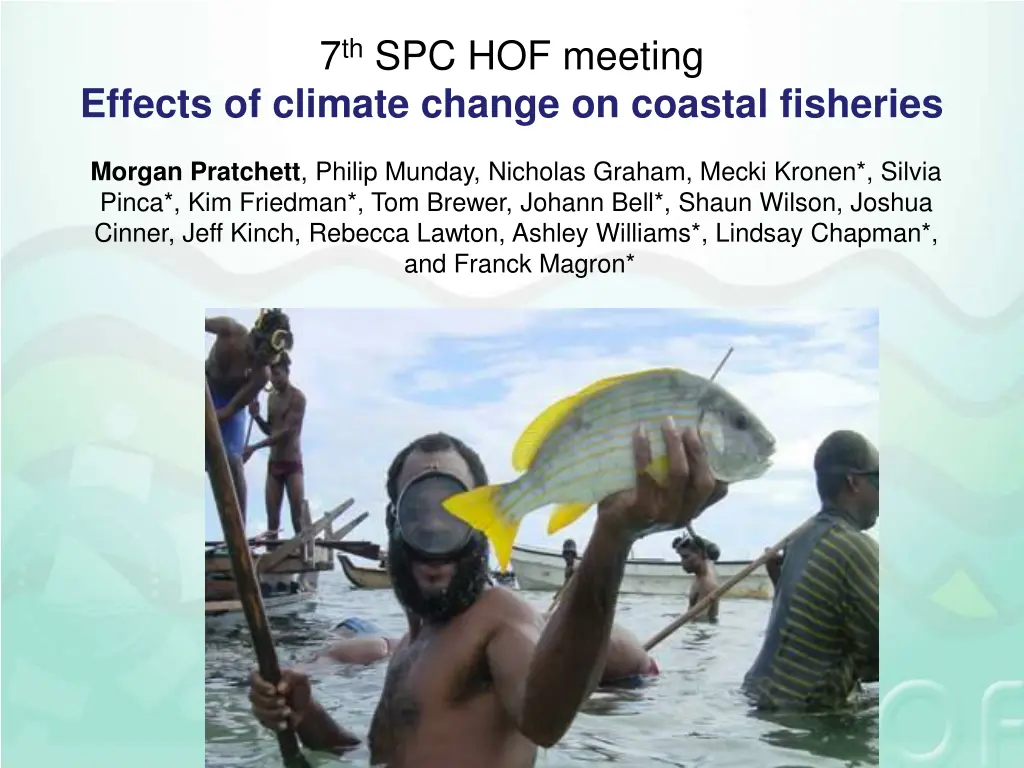
Effects of Climate Change on Coastal Fisheries
Learn about the impact of climate change on coastal fisheries, including the redistribution of species, potential decline in fisheries catches, and major changes in environmental conditions such as sea surface temperature. Explore how increasing temperatures are altering the distribution and abundance of fish species in coastal regions.
Download Presentation

Please find below an Image/Link to download the presentation.
The content on the website is provided AS IS for your information and personal use only. It may not be sold, licensed, or shared on other websites without obtaining consent from the author. If you encounter any issues during the download, it is possible that the publisher has removed the file from their server.
You are allowed to download the files provided on this website for personal or commercial use, subject to the condition that they are used lawfully. All files are the property of their respective owners.
The content on the website is provided AS IS for your information and personal use only. It may not be sold, licensed, or shared on other websites without obtaining consent from the author.
E N D
Presentation Transcript
7th SPC HOF meeting Effects of climate change on coastal fisheries Morgan Pratchett, Philip Munday, Nicholas Graham, Mecki Kronen*, Silvia Pinca*, Kim Friedman*, Tom Brewer, Johann Bell*, Shaun Wilson, Joshua Cinner, Jeff Kinch, Rebecca Lawton, Ashley Williams*, Lindsay Chapman*, and Franck Magron* Climate change and coastal fisheries Morgan.Pratchett@jcu.edu.au
Four categories of coastal fisheries 1. Demersal finfishes 2. Nearshore pelagics 3. Targeted invertebrates 4. Shallow sub tidal and intertidal invertebrates Climate change and coastal fisheries Morgan.Pratchett@jcu.edu.au
Main types of species considered Demersal finfishes 0.15 Proportional use species 0.1 0.05 0 Others Mugilidae Holocentridae Lethrinidae Kyphosidae Acanthuridae Siganidae Labridae Balistidae Scaridae Serranidae Carangidae Lutjanidae Mullidae Climate change and coastal fisheries Morgan.Pratchett@jcu.edu.au
Major changes in environmental conditions 1. Sea surface temperature (SST) 4 High emissions A2 Temperature increase (oC) 3 2 B1 Low emissions 1 0 1980 2000 2020 2040 2060 2080 2100 Climate change and coastal fisheries Morgan.Pratchett@jcu.edu.au
Redistribution of species with increased temperature Increasing latitude Decreasing temperature Climate change and coastal fisheries Morgan.Pratchett@jcu.edu.au
Redistribution of potential fisheries catch By 2050, potential fisheries catches will decline by ~40% in the tropical Pacific if species are free to move poleward with increasing temperatures (Cheung et al. 2010) Climate change and coastal fisheries Morgan.Pratchett@jcu.edu.au
Climate change and coastal fisheries Morgan.Pratchett@jcu.edu.au
Climate change and coastal fisheries Morgan.Pratchett@jcu.edu.au
Major changes in environmental conditions 1. Sea surface temperature (SST) High emissions 4 A2 Temperature increase (oC) 3 2 B1 1 Typical bleaching threshold Low emissions 0 1980 2000 2020 2040 2060 2080 2100 Climate change and coastal fisheries Morgan.Pratchett@jcu.edu.au
Major changes in environmental conditions 2. Coral cover 0 -10 -20 Severity of declines -30 -40 -50 Low emissions -60 B1 -70 -80 -90 A2 High emissions -100 1980 2000 2020 2040 2060 2080 2100 Climate change and coastal fisheries Morgan.Pratchett@jcu.edu.au
Major changes in environmental conditions 2. Coral cover 0 -10 -20 Severity of declines -30 Effective local management -40 by teams of experts -50 -60 B1 -70 -80 -90 A2 -100 1980 2000 2020 2040 2060 2080 2100 Climate change and coastal fisheries Morgan.Pratchett@jcu.edu.au
Declines in other habitats are also expected to affect coastal fisheries 2035 B1/A2 2100 Habitat B1 A2 Mangroves -10 to > -10% -50 to -70% -60 to -80% Seagrass < -5 to -20% -5 to -35% -10 to -50% Linkages between coral reefs, mangroves and seagrasses in the life cycles of coastal fish and invertebrates Climate change and coastal fisheries Morgan.Pratchett@jcu.edu.au
Climate change and coastal fisheries Morgan.Pratchett@jcu.edu.au
Fish declines exacerbated by structural collapse of coral habitats 65% decline in abundance and diversity of fishes Climate change and coastal fisheries Morgan.Pratchett@jcu.edu.au
Major changes in environmental conditions 3. Aragonite saturation (ocean acidification) 5 4.5 Severity of declines 4 3.5 3 2.5 2 1980 2000 2020 2040 2060 2080 2100 Climate change and coastal fisheries Morgan.Pratchett@jcu.edu.au
Major changes in environmental conditions 3. Aragonite saturation (ocean acidification) Loss of skeleton for corals growing under acidified conditions (Fine and Tchernov 2007) Climate change and coastal fisheries Morgan.Pratchett@jcu.edu.au
Major changes in environmental conditions 3. Aragonite saturation (ocean acidification) Climate change and coastal fisheries Morgan.Pratchett@jcu.edu.au
7th SPC HOF meeting Effects of climate change on coastal fisheries Shallow Sub-tidal & intertidal invertebrates Nearshore pelagic fish Demersal finfish Targeted invertebrates WARM & ARCH PEQD, NPTG & SPSG +40% -5% 0% -5% 0% 2035 B1/A2 -10% +35% -20% -10% -5% 2100 B1 +30% -50% -15% -20% -10% 2100 A2 Low Medium High Very High Confidence Climate change and coastal fisheries Morgan.Pratchett@jcu.edu.au
7th SPC HOF meeting Effects of climate change on coastal fisheries Coastal fisheries are sensitive to changes in - habitat quality and quantity - sea surface temperature - seawater chemistry (pH) - ocean currents and nutrient availability Up until 2035 effects of climate change may be difficult to distinguish from sustained exploitation and habitat degradation Effective local management will greatly reduce longer-term impacts of climate change on coastal fisheries Climate change and coastal fisheries Morgan.Pratchett@jcu.edu.au
7th SPC HOF meeting Adaptation and management recommendations Reverse or reduce local anthropogenic impacts that reduce the structural complexity and biological diversity of critical coastal habitats. Keep production of demersal finfish and invertebrates within sustainable limits; rebuilding populations of over-exploited species Diversify fishing activities (and livelihoods) to reduce reliance on fisheries species that are highly vulnerable to climate change Climate change and coastal fisheries Morgan.Pratchett@jcu.edu.au
